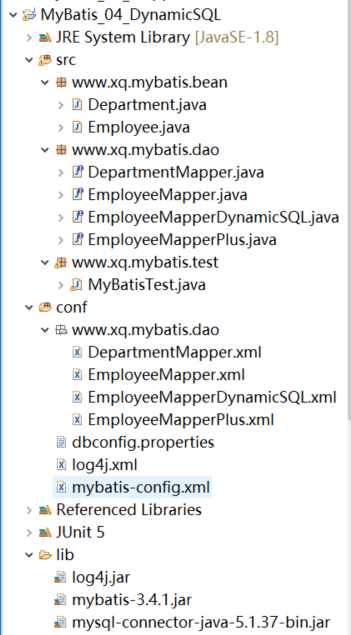工程目录

1. 环境配置
1.1 创建 EmployeeMapperDynamicSQL 接口
1.2 创建 EmployeeMapperDynamicSQL.xml 文件
2. 重要标签的使用
2.1 在 EmployeeMapperDynamicSQL 中加入
// 携带了哪个字段查询条件就带上这个字段的值
public List<Employee> getEmpsByConditionIf(Employee employee);
public List<Employee> getEmpsByConditionTrim(Employee employee);
public List<Employee> getEmpsByConditionChoose(Employee employee);
public void updateEmp(Employee employee);
// 查询员工id'在给定集合中的
public List<Employee> getEmpsByConditionForeach(@Param("ids") List<Integer> ids);
public void addEmps(@Param("emps") List<Employee> emps);
2.2 if_判断 & OGNL where_查询条件
<!-- 查询员工,要求,携带了哪个字段查询条件就带上这个字段的值 -->
<!-- public List<Employee> getEmpsByConditionIf(Employee employee); -->
<select id="getEmpsByConditionIf" resultType="www.xq.mybatis.bean.Employee">
select * from tbl_employee
<!-- where -->
<where>
<!-- test:判断表达式(OGNL)
OGNL参照PPT或者官方文档。
c:if test
从参数中取值进行判断
遇见特殊符号应该去写转义字符:
&&:
-->
<if test="id!=null">
id=#{id}
</if>
<if test="lastName!=null && lastName!=""">
and last_name like #{lastName}
</if>
<if test="email!=null and email.trim()!=""">
and email=#{email}
</if>
<!-- ognl会进行字符串与数字的转换判断 "0"==0 -->
<if test="gender==0 or gender==1">
and gender=#{gender}
</if>
</where>
</select>
2.3 trim_自定义字符串截取
<!--public List<Employee> getEmpsByConditionTrim(Employee employee); -->
<select id="getEmpsByConditionTrim" resultType="www.xq.mybatis.bean.Employee">
select * from tbl_employee
<!-- 后面多出的and或者or where标签不能解决
prefix="":前缀:trim标签体中是整个字符串拼串 后的结果。
prefix给拼串后的整个字符串加一个前缀
prefixOverrides="":
前缀覆盖: 去掉整个字符串前面多余的字符
suffix="":后缀
suffix给拼串后的整个字符串加一个后缀
suffixOverrides=""
后缀覆盖:去掉整个字符串后面多余的字符
-->
<!-- 自定义字符串的截取规则 -->
<trim prefix="where" suffixOverrides="and">
<if test="id!=null">
id=#{id} and
</if>
<if test="lastName!=null && lastName!=""">
last_name like #{lastName} and
</if>
<if test="email!=null and email.trim()!=""">
email=#{email} and
</if>
<!-- ognl会进行字符串与数字的转换判断 "0"==0 -->
<if test="gender==0 or gender==1">
gender=#{gender}
</if>
</trim>
</select>
2.4 choose_分支选择
<!-- public List<Employee> getEmpsByConditionChoose(Employee employee); -->
<select id="getEmpsByConditionChoose" resultType="www.xq.mybatis.bean.Employee">
select * from tbl_employee
<where>
<!-- 如果带了id就用id查,如果带了lastName就用lastName查;只会进入其中一个 -->
<choose>
<when test="id!=null">
id=#{id}
</when>
<when test="lastName!=null">
last_name like #{lastName}
</when>
<when test="email!=null">
email = #{email}
</when>
<otherwise>
gender = 0
</otherwise>
</choose>
</where>
</select>
2.5 set_与if结合的动态更新
<!--public void updateEmp(Employee employee); -->
<update id="updateEmp">
<!-- Set标签的使用 -->
update tbl_employee
<set>
<if test="lastName!=null">
last_name=#{lastName},
</if>
<if test="email!=null">
email=#{email},
</if>
<if test="gender!=null">
gender=#{gender}
</if>
</set>
where id=#{id}
<!--
Trim:更新拼串
update tbl_employee
<trim prefix="set" suffixOverrides=",">
<if test="lastName!=null">
last_name=#{lastName},
</if>
<if test="email!=null">
email=#{email},
</if>
<if test="gender!=null">
gender=#{gender}
</if>
</trim>
where id=#{id} -->
</update>
2.6. foreach_遍历集合
<!--public List<Employee> getEmpsByConditionForeach(List<Integer> ids); -->
<select id="getEmpsByConditionForeach" resultType="www.xq.mybatis.bean.Employee">
select * from tbl_employee
<!--
collection:指定要遍历的集合:
list类型的参数会特殊处理封装在map中,map的key就叫list
item:将当前遍历出的元素赋值给指定的变量
separator:每个元素之间的分隔符
open:遍历出所有结果拼接一个开始的字符
close:遍历出所有结果拼接一个结束的字符
index:索引。遍历list的时候是index就是索引,item就是当前值
遍历map的时候index表示的就是map的key,item就是map的值
#{变量名}就能取出变量的值也就是当前遍历出的元素
-->
<foreach collection="ids" item="item_id" separator=","
open="where id in(" close=")">
#{item_id}
</foreach>
</select>
2.7 测试
@Test
public void testDynamicSql() throws IOException{
SqlSessionFactory sqlSessionFactory = getSqlSessionFactory();
SqlSession openSession = sqlSessionFactory.openSession();
try{
EmployeeMapperDynamicSQL mapper = openSession.getMapper(EmployeeMapperDynamicSQL.class);
//select * from tbl_employee where id=? and last_name like ?
//测试if\where
Employee employee = new Employee(1, "Admin", null, null);
/* List<Employee> emps = mapper.getEmpsByConditionIf(employee );
for (Employee emp : emps) {
System.out.println(emp);
}*/
//查询的时候如果某些条件没带可能sql拼装会有问题
//1、给where后面加上1=1,以后的条件都and xxx.
//2、mybatis使用where标签来将所有的查询条件包括在内。mybatis就会将where标签中拼装的sql,多出来的and或者or去掉
//where只会去掉第一个多出来的and或者or。
//测试Trim
/*List<Employee> emps2 = mapper.getEmpsByConditionTrim(employee);
for (Employee emp : emps2) {
System.out.println(emp);
}*/
//测试choose
/*List<Employee> list = mapper.getEmpsByConditionChoose(employee);
for (Employee emp : list) {
System.out.println(emp);
}*/
//测试set标签
/*mapper.updateEmp(employee);
openSession.commit();*/
//测试 foreach
List<Employee> list = mapper.getEmpsByConditionForeach(Arrays.asList(1,2));
for (Employee emp : list) {
System.out.println(emp);
}
}finally{
openSession.close();
}
}
3. 标签的应用
3.1 批量保存
3.1.1. Employee 类设计
package www.xq.mybatis.bean;
import org.apache.ibatis.type.Alias;
@Alias("emp")
public class Employee {
private Integer id;
private String lastName;
private String email;
private String gender;
private Department dept;
public Employee() {
super();
}
public Employee(Integer id, String lastName, String email, String gender, Department dept) {
super();
this.id = id;
this.lastName = lastName;
this.email = email;
this.gender = gender;
this.dept = dept;
}
public Employee(Integer id, String lastName, String email, String gender) {
super();
this.id = id;
this.lastName = lastName;
this.email = email;
this.gender = gender;
}
public Department getDept() {
return dept;
}
public void setDept(Department dept) {
this.dept = dept;
}
public Integer getId() {
return id;
}
public void setId(Integer id) {
this.id = id;
}
public String getLastName() {
return lastName;
}
public void setLastName(String lastName) {
this.lastName = lastName;
}
public String getEmail() {
return email;
}
public void setEmail(String email) {
this.email = email;
}
public String getGender() {
return gender;
}
public void setGender(String gender) {
this.gender = gender;
}
@Override
public String toString() {
return "Employee [id=" + id + ", lastName=" + lastName + ", email="
+ email + ", gender=" + gender + "]";
}
}
3.1.2. Department 类设计
package www.xq.mybatis.bean;
import java.util.List;
public class Department {
private Integer id;
private String departmentName;
private List<Employee> emps;
public Department(Integer id) {
super();
this.id = id;
}
public List<Employee> getEmps() {
return emps;
}
public void setEmps(List<Employee> emps) {
this.emps = emps;
}
public Integer getId() {
return id;
}
public void setId(Integer id) {
this.id = id;
}
public String getDepartmentName() {
return departmentName;
}
public void setDepartmentName(String departmentName) {
this.departmentName = departmentName;
}
@Override
public String toString() {
return "Department [id=" + id + ", departmentName=" + departmentName
+ "]";
}
}
3.1.3. EmployeeMapperDynamicSQL 接口设计
public void addEmps(@Param("emps") List<Employee> emps);
3.1.4. EmployeeMapperDynamicSQL.xml 设计
<!-- 批量保存 -->
<!--public void addEmps(@Param("emps")List<Employee> emps); -->
<!--MySQL下批量保存:可以foreach遍历 mysql支持values(),(),()语法-->
<insert id="addEmps">
insert into tbl_employee(
last_name,email,gender,d_id
)
values
<foreach collection="emps" item="emp" separator=",">
(#{emp.lastName},#{emp.email},#{emp.gender},#{emp.dept.id})
</foreach>
</insert>
<!-- 这种方式需要数据库连接属性allowMultiQueries=true;
这种分号分隔多个sql可以用于其他的批量操作(删除,修改) -->
<!-- <insert id="addEmps">
<foreach collection="emps" item="emp" separator=";">
insert into tbl_employee(last_name,email,gender,d_id)
values(#{emp.lastName},#{emp.email},#{emp.gender},#{emp.dept.id})
</foreach>
</insert> -->
3.1.5. 测试
@Test
public void testBatchSave() throws IOException{
SqlSessionFactory sqlSessionFactory = getSqlSessionFactory();
SqlSession openSession = sqlSessionFactory.openSession();
try{
EmployeeMapperDynamicSQL mapper = openSession.getMapper(EmployeeMapperDynamicSQL.class);
List<Employee> emps = new ArrayList<>();
emps.add(new Employee(null, "smith0x1", "[email protected]", "1",new Department(1)));
emps.add(new Employee(null, "allen0x1", "[email protected]", "0",new Department(1)));
mapper.addEmps(emps);
openSession.commit();
}finally{
openSession.close();
}
}
3.2 内置参数_parameter&_databaseId & bind_绑定
3.2.1. 简介
- 两个内置参数:
-
不只是方法传递过来的参数可以被用来判断,取值。。。
-
mybatis默认还有两个内置参数:
- _parameter:代表整个参数
- 单个参数:_parameter就是这个参数
- 多个参数:参数会被封装为一个map;_parameter就是代表这个map
- _parameter:代表整个参数
-
_databaseId:如果配置了databaseIdProvider标签。
- _databaseId就是代表当前数据库的别名oracle
-
3.2.2. 实例
<!--public List<Employee> getEmpsTestInnerParameter(Employee employee); -->
<select id="getEmpsTestInnerParameter" resultType="www.xq.mybatis.bean.Employee">
<!-- bind:可以将OGNL表达式的值绑定到一个变量中,方便后来引用这个变量的值 -->
<bind name="_lastName" value="'%'+lastName+'%'"/>
<if test="_databaseId=='mysql'">
select * from tbl_employee
<if test="_parameter!=null">
where last_name like #{lastName}
</if>
</if>
<if test="_databaseId=='oracle'">
select * from employees
<if test="_parameter!=null">
where last_name like #{_parameter.lastName}
</if>
</if>
</select>
3.3 抽取可重用的sql片段
3.3.1. 简介
- sql抽取:经常将要查询的列名,或者插入用的列名抽取出来方便引用
- include来引用已经抽取的sql:
- include还可以自定义一些property,sql标签内部就能使用自定义的属性
- include-property:取值的正确方式${prop},
- #{不能使用这种方式}
3.3.2. 实例
<sql id="insertColumn">
<if test="_databaseId=='oracle'">
employee_id,last_name,email
</if>
<if test="_databaseId=='mysql'">
last_name,email,gender,d_id
</if>
</sql>
<insert id="addEmps">
insert into tbl_employee(
<include refid="insertColumn"></include>
)
values
<foreach collection="emps" item="emp" separator=",">
(#{emp.lastName},#{emp.email},#{emp.gender},#{emp.dept.id})
</foreach>
</insert>